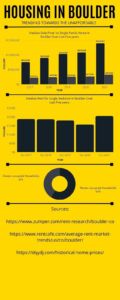The best city in the US to live is the least affordable for students and minorities
Boulder, race, and the rest of the country.
The city of Boulder prides itself on diversity, inclusion, and acceptance of all people. You can see it in their marketing, flags on the street, and Black Lives Matter signs staked in front of homes throughout the city.
But those same homes sporting calling cards of proud diversity are locked to those who would actually make for a diverse community. They’re locked, like a cooking article in the NYT, behind a paywall, and not just any paywall, but a 42% above the national average, nasty outlier paywall. The price of those homes – averaging over 1.4 million dollars – is simply unattainable for most Americans, much less a freshly-graduated college student.
In fact, according to the city’s website, Boulder is 87.7% white, compared to the national 72%. There’s a reason why Boulder is predominantly white, and it relates directly to housing. According to the Federal Reserve, Black families’ median and mean wealth is less than 15% that of white families nationwide.
White families by far share the highest amount of wealth in the United States, meaning that they are the most likely to afford the significant housing and rent prices found in Boulder. About 46% of white families own their homes, while only 17% of black families own theirs. Boulder is essentially a real-time, physical manifestation of this wealth gap, as only 1.3% of persons in Boulder are Black.
This inequality is a deep and complex issue, but it is worth noting. Boulder is a place where liberal ideas thrive, acceptance is celebrated, and anti-racism is championed, yet Boulder, by its own design, bars people of color out of its city limits with a financial strong-arm wielding a big stick.
What the city of Boulder wants to be is not found in their marketing, is not found in murals in the Norlin library, is not found in street-signs or campaign posters – it’s found in the numbers.
Boulder is a haven for white people who smack around pat-on-the-back ideas but take actions that in no way benefit people of color, in no way attempt to make a diverse community, in no way fix the social issues they are so proud to have the right opinions on. In actuality, they perpetuate long-standing systems of financial racial tension.
For the people that live in Boulder, though, housing is clearly a problem.
Take another city similar to Boulder: Knoxville, Tenn. Now, it is true that Knoxville and Boulder differ on characteristics like average income and job proliferation rates, but both cities are of comparable size (Knoxville having about 30,000 more people than Boulder) and have the state’s largest university located in the city.
Knoxville, like Boulder, has also seen a dramatic upward trend in housing prices, according to redfin.com. The average price of a single-family home in Knoxville as of October 2021 was $311,000, which happens to be moderately above the median value of a home in the United States ($240,500).
Judging by these numbers, it is no surprise that Knoxville’s racial makeup reflects the national averages – the city is 72.4% white and 17% Black.
Another main difference between Boulder and Knoxville, or any other medium-sized city that hosts a large university, is that the students at those universities can live there when they graduate. Not every student leaves Boulder upon graduation, but many, like current senior Mic Obleski, plan on leaving due to one important factor.
“I was definitely not trying to live in Boulder, but I do know that I would not be able to,” said Obleski.“Living in Denver is a lot cheaper, so it’s probably a much better move.”
 Throwing a blind dart: how Boulder’s landlords makeup rent at the expense of students
Throwing a blind dart: how Boulder’s landlords makeup rent at the expense of students
In Boulder, only 41% of the homes are owner-occupied, compared to the national average of 64.1%, according to the city’s website. The reason for this could be that, since house prices are so large and wages for most of Boulder’s jobs simply do not meet what’s required to buy a home without incurring massive debt, people are forced to rent if they want to live close to their jobs.
Rent, for the average person in the remaining 59%, stands at $2,171 per month, according to Jeff Morris, the director for CU’s off-campus housing and neighborhood relations office. The national median gross rent per person is $1,097, with Colorado’s being $1,369.
Morris says that these high prices cause most of the faculty members at CU to live outside Boulder, and they are forced to commute to work.
Jeff Morris brings years of experience to the vastly underappreciated but incredibly important job of mitigating student’s first move off campus and what he describes as vulturous landlords. Hired in 2019, Morris hopes to ensure that CU students can not only find a place to live, but that they can survive the many pitfalls that come with signing a lease at 19 years old.
Every day Morris and his team of three, including one lawyer who sees over 300 cases of security deposit fraud every semester, fight for students in the hopes that they can afford to live in the neighborhoods which make CU such an appealing college for so many from so far. Because of the nature of his job, Morris is in tune with the upward trend of housing prices and knows who is to blame.
“I attribute that to all of these developers coming into Boulder,” said Morris.“You have Google, Apple is on its way. And they’re building all this housing, but those companies are so large they’re able to make those rental prices in those properties five grand, and then they’re paying their employees the rental prices. But if you do that, that’s actually going into the rental market and it’s fluctuating the numbers for everybody else who doesn’t work for those companies.”
These companies building houses certainly are not the only thing affecting rent prices for students. Morris said that investors will walk door to door on the Hill and knock on owner (not student rented, but families and professionals) occupied homes with a briefcase, offering those homeowners as much as $300,000 over the house’s listed value in order to turn that home into student housing. In ten years, investors will make their money back by renting to students in something Morris calls “guaranteed money.”
Moving to Boulder, with its beautiful vistas and promise of lovely living, has been a desire for many ever since word of the Flatirons spread across the country. Many from New York, Chicago, and California look to Boulder to escape the hectic city life and settle in the open air of Colorado. In 2016, according to rentcafe.com, a higher income family wishing to purchase a single-family home within the city limits faced a steep $752,050 price. But as of April 2021, that price has skyrocketed to $1.4 million dollars. This is not normal.
Rent is increasing on average at about 3% per year, which is not incredibly high, but it is tied to the interest rate on home mortgages. The rent will be high to start with because housing prices are already high, but the way the rent values are actually designed, Morris explained, is shocking.
“It’s just landlords throwing a dart at a wall,” said Morris.“They aren’t basing it off those rental averages, they’re basing it off what they think they can get, which in turn will drive those average prices up.”
He also described the situation that birthed this kind of bizarre and unfair rent calculation. It starts with an already affluent (and overwhelmingly white) student population who can afford some of the high prices. Morris claims these demographics set off a positive feedback loop that affects other students who can’t necessarily afford rent in Boulder, but are forced to live in the city because, after all, they are students who are required to be in class and who have friends that they want to live nearby.
“It’s a weird catch-22. If the landlords know these students can afford these prices because they are writing these checks, why wouldn’t they have the prices be so high?” Morris said.
Yes, students are able to afford the rent on these homes, especially on the Hill. However, Morris claims that this causes students to look to illegal measures in order to afford rent as a collective.
“What that does, in turn, it forces our students to over-occupy,” said Morris.“We can only have three to four students in an apartment or house. If you have two additional bedrooms in this space, then why wouldn’t you have two more students move in and split rent so it’s cheaper?”
What he was referring to was one of Boulder’s housing laws. Written in stone more solid than the Flatirons, the law requires the majority of homes in Boulder to allow no more than three unrelated occupants. This means that if a home has four bedrooms, only three people can occupy it, which causes either awkward, unused bedrooms, or, for many renters in Boulder, to over-occupy in order to make rent and have a place to live.
Even with these options, some students are simply left behind. Though much of the student population is affluent, and though the student population can by and large afford these prices, a lot of students are forced into less-than-ideal living situations.
Many students come to Boulder to experience the greatness that is offered on pamphlets, flyers, and emails featuring magnificent photos of the Flatirons combined with happy and laughing individuals. In many ways, Boulder is as advertised, but incoming students who are not familiar with local housing prices, especially out of state students, don’t do their homework, and like Zach Horan, a CU Senior, come to find a rude awakening.
“I hate my situation, but I have no other options,” said Horan. “As much as I love living in Boulder, the prices are too high and I’m going to have to move somewhere else, as much as I wouldn’t want to.”
The battle for bedrooms and solutions for the future
Sarahdawn Haynes is a 20-year renter in Boulder who works for CU’s Environmental Center as an Outreach and Engagement Coordinator, but she also is deeply involved in a grassroots organization known as Bedrooms are for People. The organization’s mission is to change the occupancy law to allow for one unrelated occupant per bedroom in any given home, a seemingly logical choice that has met a lot of backlash from the city council.
Haynes claims this backlash is rooted in deep superstitions and logical fallacy.
“There’s this myth that all renters are students, and all students are frat boys that they will use, but it’s like, ‘hey, guess what, forty-year-olds who don’t have kids have roommates because it’s expensive to live here.’ The arguments against are either people lying about what we are trying to do, or they are just kind of caught in their worst-case scenario, hyperbolic echo chambers,” Haynes said.
She’s right. Take a look at the opposition website to Bedrooms are for People, No On Bedrooms. First, the website claims that “the city cannot afford” the bedrooms initiative (in a city where the median family income is $47,000 dollars over the national average), then claims that “Areas with existing high density student housing such as University Hill, where houses with 8-12 occupants are currently permitted, experience heavy impacts as seen in the 18,000+ calls for police service on the Hill in the last two years, and the alcohol fueled riot on March 6, 2021.”
The website then encourages readers to watch Hill riot footage. While the Hill riot last year in March was inarguably an embarrassment for the University and the students that attend, to implicate organizations like Bedrooms are for People in causing the riot and to subtly imply that changing the occupancy laws will lead to further riots is simply a way to manufacture a nefarious force that does not exist.
Riots like this one have happened in the past, like the one in 1997 that injured 12 police officers. These riots are caused by students, and happen in the neighborhoods students live in.
Students have always been over-occupying homes, and making it legal for them to do so will not change the number of students centered in one neighborhood.
The website goes on to feature pictures of student homes on the hill overflowing with trash, before showing the organization’s true colors:
“Many of us have worked for years on housing issues in Boulder, particularly on issues related to student housing and the rental property industry. Based on our extensive knowledge and long experience with these topics, it is clear to us that Bedrooms Are For People will NOT create a more diverse, affordable or resilient community, but will irreparably damage the fabric of our neighborhoods,” No On Bedrooms claims.
It seems that, to them, students exist to damage. Unfortunately, students that attend a university will likely need to live near that university. They do have to go to class, after all, and the Hill allows students easy access to the university, businesses, and entertainment venues where they become valuable participants in Boulder’s economy.
Bedrooms are for People is looking to solve the issue of higher housing prices by matching the number of bedrooms to the number of people living in them, but Jeff Morris is skeptical of this idea, and not for the same reasons that many older homeowners and organizations like No On Bedrooms claim.
“In our mind, you increase the occupancy rates, you’re going to increase rent. Well, for us, students are over-occupying and are able to afford rent because they are over-occupying, and if you make over-occupying legal, that landlord is going to turn a six-bedroom house that’s $3,000 to a $6,000 house,” Morris said.
He added that he thinks it’s great that students wouldn’t get in trouble for over-occupying, but worries that that could lead to an increase in rental rates. He thinks the Bedrooms are for People initiative will not help the financial capacity of what students can afford, but exactly the opposite.
“It’s just a really interesting conversation to be having for so long,” Morris said.
Haynes thinks otherwise.
“Could the overall rent increase? That would make sense to me in some sense, but it would still usually be cheaper. The thing is, there’s a value of the house, value of the property, what’s legal for a family, if it’s legal and safe for people who are blood related, it should be legal and safe for people who are not blood related. That doesn’t change the value of the property. The use of the house, and maintenance, there’s a value on that. The reason we get more roommates is to make the rent cheaper,” Haynes said.
Whatever the occupancy laws are, the price of the home is not going to change. The question then becomes whether or not landlords are going to be able to charge more, which is a possibility Bedrooms are for People has to face. In the end, though, Bedrooms are for People is working to make Boulder the “best city to live in the United States,” an affordable city to live for people who are part of the working class, and also less white.
Haynes said that she looks at bedrooms as part of a solution to the climate crisis. A small part, but she argues that the environmental thing to do is not build more housing, which means acquiring building materials and then using those materials on previously unused land. She said that it is much more environmentally friendly to use current housing more efficiently rather than build new units that take away open space land and up Boulder’s carbon footprint.
Haynes is deeply aware of the problem of Boulder’s housing, and how it affects diversity within the city. She is actively taking viable solutions to city council, fighting to make Boulder a better, more environmental, place for all peoples.
The problem, after all, is investors buying up housing in a high-demand market and slapping a huge asking price for those who want to move to Boulder, which is a lot. For people like Haynes, it is nearly a battle of being able to live where one works or being forced out.
“I can only afford to live by myself if I leave,” Haynes said.
 Jeff Morris: Jeff.Morris@colorado.edu
Jeff Morris: Jeff.Morris@colorado.edu
 Sarahdawn Haynes: dawnofsarah@gmail.com
Sarahdawn Haynes: dawnofsarah@gmail.com
Mic Obleski: (303) 909-3224

